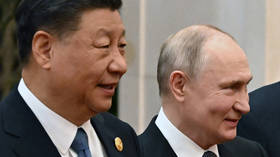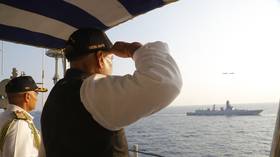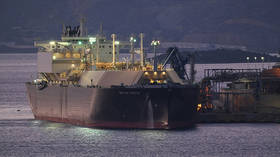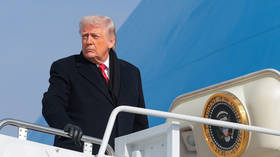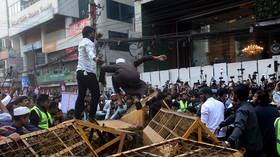Will India join the US-China tug-of-war?
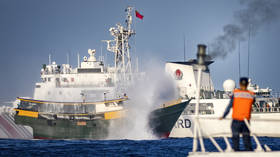
The Philippines deployed ships to a disputed area in the South China Sea over the weekend to stop what it called China’s “alarming activities.” The office of President Ferdinand Marcos Jr. said in a statement that patrol ships will monitor the alleged “illegal activities of China” in creating “an artificial island” on Escoda Shoal in the West Philippine Sea.
The latest development comes amid the two countries’ ongoing conflict over the territory.
Earlier this month, the Philippines conducted Balikatan drills (‘shoulder-to-shoulder’ in Tagalog) with the US. More than 16,000 American and Philippines military personnel participated in this largest-ever annual military exercise. The drills also included more than 250 French and Australian forces, along with observers from several security partner nations, led by Japan.
China’s claims in West Philippine Sea
The drills took place against the backdrop of growing assertiveness by Beijing in the South China Sea. On April 23, two Philippines patrol boats approached the shallow turquoise waters of a disputed shoal located around 194km (121 miles) west of the Philippines province of Palawan for an underwater survey near a disputed shoal in the West Philippine Sea.
A Chinese coast guard ship instructed them via radio to leave the area and threatened hostile measures. Following several radio exchanges, the Chinese coast guard crew damaged both of the Philippines patrol boats by firing high-pressure water cannons at them. In the history of conflicts in the South China Sea, this encounter was among the most intense.
Earlier, there were also several confrontations between the Philippines and China in disputed islands of the West Philippine Sea, particularly at the Second Thomas Shoal and the Bashi Channel.
China has long insisted that the Philippines remove its tiny naval presence and tow away the BRP Sierra Madre, which is still in active service but in crumbling condition. In 1999, the naval ship was purposefully abandoned on the shoal, and it now stands as a precarious reminder of Manila’s territorial claims to the atoll. Chinese ships frequently obstruct naval ships carrying provisions and other supplies for Philippines sailors aboard. The Philippines government and private vessels are frequently involved in dangerous altercations with the China Coast Guard and maritime militia. Since last year, however, there seems to be an increasing number of altercations between Beijing and Manila.
China has used a U-shaped ‘nine-dash line’ that crosses the exclusive economic zones of Brunei, Indonesia, Malaysia, the Philippines, Taiwan, and Vietnam to demonstrate its claim in the region, which lies along a vital trade and supply corridor that supports over $3 trillion in yearly shipborne commerce.
Oil, gas, and fishing sources abound in the area. Beijing has declined to acknowledge a 2016 international arbitration decision from a Hauge court connected with the UN that ruled Beijing’s broad claims invalid based on historical grounds.
Concerns for India
In January 2022, the Philippines signed a $375 million contract with India for three batteries of the shore-based, anti-ship BrahMos missile, making it the first exporter of the joint venture missile between Russia and India. Together with the required Integrated Logistics Support package, operator, and maintenance training, the delivery of three missile batteries is also included in the deal. The Philippine Marines’ coastal defense regiment will primarily use the missile systems.
According to the agreement, India will give the Philippines the first BrahMos supersonic cruise missiles in April 2024. The Philippines is purchasing the systems as part of its Revised Armed Forces of the Philippines Modernization Program. Once operationalized, this delivery will strengthen the Philippines armed forces’ defensive position.
During a visit to the Philippines in March 2024, Indian External Affairs Minister Subrahmanyam Jaishankar gave the government assurances about India’s commitment to maintaining an international order based on norms and advancing security and peace in the Indo-Pacific region. Before that, 21 Philippines Navy personnel received training in Nagpur from January 23 to February 11, 2023 on system operations and maintenance. India and the Philippines are now considering sending an Indian defense attaché to monitor security developments and plan to strengthen bilateral defense cooperation. The military attaché is anticipated to be stationed in Manila by the end of 2024.
Lastly, India’s largest private port operator, APSEZ (Adani Ports and Special Economic Zone), is looking at the Philippines’ Bataan for its port expansion plan. The business intends to build a port that can handle Panamax boats and is 25 meters deep. Meanwhile, Adani Group plans to invest in the Philippines’ ports, airports, electricity, and defense industries.
This demonstrates India’s concern in this area, but the country is conscious of its limitations. Even though it has been almost ten years, the INS Airavat event is still vivid in the minds of decision-makers. Even though the Indian authorities have dismissed it, China’s claim in the South China Sea and India’s inability to combat China far from its immediate neighborhood is real. In fact, India has declared that the Indian Ocean, encompassing the Arabian Sea and the Bay of Bengal, is its top priority. Beyond that, India has no direct interest.
Nonetheless, India decided to station three of its ships in the area: The guided missile destroyer INS Delhi, the fleet tanker INS Shakti, and the anti-submarine warfare stealth corvette INS Kiltan. INS Kadmatt visited Thailand in December 2023 as part of a long-range operational deployment. It docked in Manila around the same time. The present deployment is further evidence of India’s concern for the area.
India and the US: Shared agenda, separate action
Notwithstanding India’s efforts, its conservative posture on the South China Sea has, to some extent, irked the US. This is also reflected in the US’ growing impatience over the utility of QUAD. Recently, the US replaced India with the Philippines in the new security alliance known as ‘SQUAD’. However, leaving India out of SQUAD reflects more US bias than India’s limitations. Unlike India, the Philippines is a mutual defense treaty ally of the US. But more importantly, the US has been unhappy over India’s close bonding with its traditional security partner Russia and the way India has openly defied Western-led sanctions on Moscow over the Ukraine conflict.
Additionally, India decided not to join a US-led initiative in the Red Sea. Even though ten Indian navy ships are currently on patrol in the area where Houthi rebels have been using drones and anti-ship missiles, India’s refusal to back the US-led maritime alliance did not sit well with US policymakers, and some even referred to India’s position as opportunistic.
Concerns about the stability of the region are at an all-time high. Meanwhile, President Marcos is working to also forge ties beyond the US. He has made contact with a number of potential allies, including Australia, Japan, and Vietnam – another country that has been the target of China’s muscle-flexing.
Beijing has expressed dissatisfaction with these attempts to bring Washington into the game – stressing the need to keep South China Sea issues bilateral. It warned the US against meddling.
The timing of the current skirmish surprisingly coincides with the visit of Chinese Foreign Minister Qin Gang. While the Chinese ship was taking violent action against the patrol vessel from the Philippines, the Chinese foreign minister was busy in Manila talking about the settlement of issues and strengthening ties with his colleague in the Philippines and Marcos.
Undoubtedly, any serious conflict between China and the Philippines would be dangerous. The idea of these coast guard skirmishes in the Spratly Islands leading to World War III seems far-fetched. Yet, the risk of casualties or a vessel capsizing is not improbable. Any event such as this would spark a major crisis requiring quick de-escalation measures from both the US and China. India remains vigilant.
The statements, views and opinions expressed in this column are solely those of the author and do not necessarily represent those of RT.

